The Basic Notions for (over, off, under) Neutrosophic Geometric Programming Problems
1,3
Huda E. Khalid1 Florentin Smarandache2 Ahmed K. Essa3 University of Telafer, Administrator of the President Office, Telafer, Iraq. E-mail: hodaesmail@yahoo.com 2 University of New Mexico, 705 Gurley Ave., Gallup, NM 87301, USA. E-mail: smarand@unm.edu

Abstract. Neutrosophic (over, off, under) set and logic were defined for the first time in 1995 by Florentin Smarandache, and presented during 1995-2018 to various national and international conferences and seminars. The (over, off, under) neutrosophic geometric programming was put forward by Huda et al. in (2016) [8], in an attempt to define a new type of geometric programming using (over, off, under) neutrosophic less than or equal to. This paper completes the basic notions of (over, off, under) neutrosophic geometric programming illustrating its convexity condition, and its decomposition theorems. The definitions of ( ) and strong ( ) are introduced, and some of their important properties are proved.
Keyword: Neutrosophic Set (NS), Neutrosophic Geometric Programming (NGP), (Over, Off, Under) Neutrosophic Convex Set, (sleeves, neut-sleeves, anti-sleeves) of Neutrosophic Sets, Ideal Sleeves, ( ) , Strong ( ) , Excluded Middle Law, Decomposition Theorems;
Introduction
B. Y. Cao set up the mathematical fundamentals of fuzzy geometric programming (FGP) [1], and introduced it at the second IFSA conference, in 1987, in (Tokyo). The formulation and uniqueness of the maximum solution of fuzzy neutrosophic geometric programming in the type of relational equations were firstly introduced by H.E. Khalid [19], later there was a novel method for finding the minimum solution in the same fuzzy neutrosophic relational equations on geometric programming presented on 2016 [15]. The most important paper which related with the basic role of this paper which regarded as the first attempt to present the notion of (over, off, under) neutrosophic less than or equal in geometric programming was established by Florentin S. and Huda E. [8] The NGP method has been admitted by specialists and created a new branch of neutrosophic mathematics. Inspired by Smarandache’s neutrosophic sets theory and (over, off, under) neutrosophic set theory [2, 5, 6], neutrosophic geometric programming emerges from the combination of neutrosophic sets with geometric programming. The present paper intends to discuss the (over, off, under) convexity in neutrosophic sets, introducing a new definition for convexity, and graphing the geometrical representations for (over, off, under) convexity property. Neutrosophic sleeves, neutrosophic neutsleeves and neutrosophic anti-sleeves are also introduced in this research. Because each neutrosophic set can uniquely be represented by the family of all its ( ) , it is useful to enunciate the definition of ( ) and prove some of its properties, similarly talking for strong ( )
. Any neutrosophic mathematical programming cannot be generated from the womb of fuzzy mathematical programming without the passage through intuitionistic fuzzy mathematical programming [17, 18], so we should be familiar with all aspects of intuitionistic mathematical programming fundamentals from the point of view of K. T. Atanassov [13, 16].
1 (Over, Off, Under) Convexity Property in Neutrosophic Sets
In this section, a new convexity behavior of the neutrosophic set will be given. Let be an ordinary set whose generic elements are denoted by ( ) is the set of all neutrosophic sets included in X.
Huda E. Khalid, Florentin Smarandache & Ahmed K. Essa, “The Basic Notions for (over, off, under) Neutrosophic Geometric Programming Problems”
1.1 Definition [19]
A neutrosophic set ( ) is defined as * ( ) ( ) ( ) + where ( ) ( ) ( ) represent the membership function, the indeterminacy function, the nonmembership function respectively.
1.2 Definition [4]
A mapping , - ( ) ( ) ( ) is called a collection of neutrosophic elements, where a membership corresponding to a neutrosophic set , ( ) an indeterminacy membership corresponding to a neutrosophic set , ( ) a non-membership corresponding to a neutrosophic set .
1.3 Definition
Suppose ( ). If , we call that is an (over, off, under) convex neutrosophic set, iff the following conditions hold together:
1- ( ( ) ) ( ( ) ( ) 2- Let ( ) ( ) ( ) and a- ( ) satisfies the convex condition, i.e. ( ( ) ) ( ( ) ( ) b- ( ) satisfies the concave condition, i.e. ( ( ) ) ( ( ) ( )) for some c- ( ) is neither convex nor concave at where ( ) , and , ( i.e. ( ) ( ) ( ) ) 3- ( ( ) ) ( ( ) ( ))
For more details, see Figures 1, 2, and 3.
2 Geometrical Representation
This section illustrates the geometrical representation of the (over, off, under) convexity behavior in neutrosophic sets. Figures 1,2 and 3 illustrate the given notion as follow:
Figure 1: The convex condition of the truth membership function ( )
Here, () ( ( ) ( ) , where ( ( ) ) , -, satisfying the condition for all
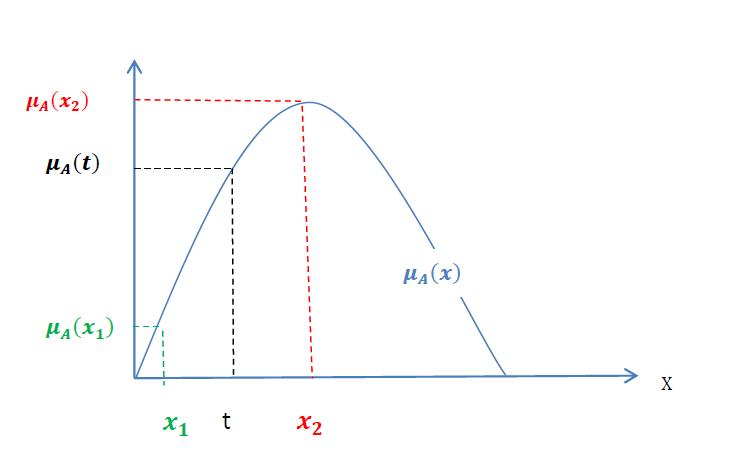 Huda E. Khalid, Florentin Smarandache & Ahmed K. Essa, The Basic Notions for (over, off, under) Neutrosophic Geometric Programming Problems
Huda E. Khalid, Florentin Smarandache & Ahmed K. Essa, The Basic Notions for (over, off, under) Neutrosophic Geometric Programming Problems
Figure 2: The concave condition of the falsehood membership function ( )
Here, () ( ( ) ( )) , where ( ( ) ) , - the condition is happening for all .
Figure 3: Here the indeterminate function is constructed from the intersection between the truth and falsehood membership functions; i.e. ( ) ( ) ( ). In this figure, the dashed point lines (i.e. shaded with green points represent the indeterminate region, here ( ) is neither convex nor concave at ( ) ( ) ( ) , where ( ) , and
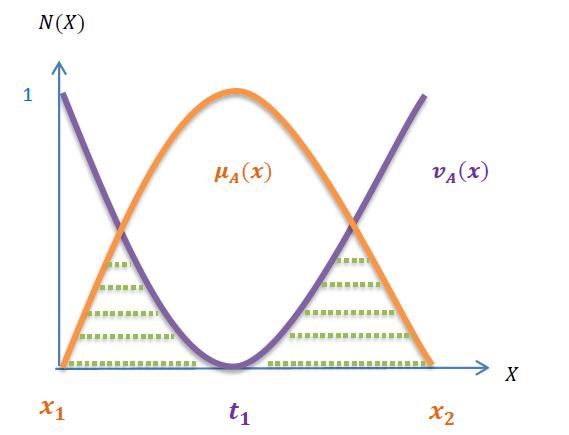

3 Neutrosophic Sleeves, Neutrosophic Anti-sleeves, Neutrosophic Neut-sleeves
This section introduces for the first time the notion of neutrosophic sleeves, its contradiction and its neutrality. Together with the definitions of the neutrosophic sleeve, neutrosophic anti-sleeve, neutrosophic unit-sleeve, we provided graphs; however, the graphs are imprecise, offering an illustration of the meaning of composite sleeves.
Huda E. Khalid, Florentin Smarandache & Ahmed K. Essa, The Basic Notions for (over, off, under) Neutrosophic Geometric Programming Problems
3.1 Definition
If a set-valued mapping , - ( ) satisfies , - ( ) ( ), then is called a collection neutrosophic sleeve on . A set composed of all the collections of neutrosophic sleeves on is written as ( ) The ideal sleeve occurs when ( ) ( )
Figure 4: Neutrosophic sleeve
Figure 5: Neutrosophic ideal sleeve
3.2 Definition
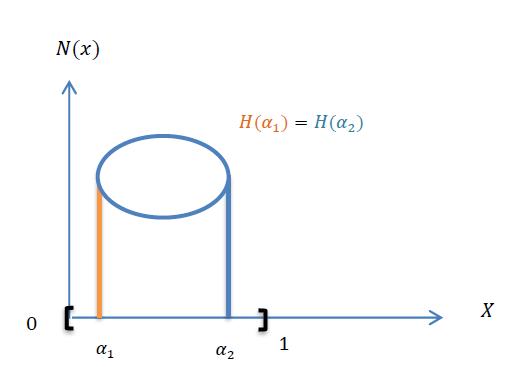
If a set-valued mapping , - ( ) satisfies ,( ) ( ), then is called a collection of neutrosophic anti-sleeves on . A set composed of all the collection of neutrosophic anti-sleeves on is written as ( ). The ideal neutrosophic anti-sleeve on occures when ( ) ( ).
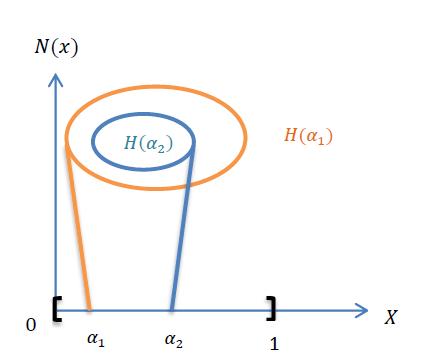 Huda E. Khalid, Florentin Smarandache & Ahmed K. Essa, The Basic Notions for (over, off, under) Neutrosophic Geometric Programming Problems
Huda E. Khalid, Florentin Smarandache & Ahmed K. Essa, The Basic Notions for (over, off, under) Neutrosophic Geometric Programming Problems
Figure 6: Neutrosophic anti-sleeve
Figure 7: Neutrosophic ideal anti-sleeve
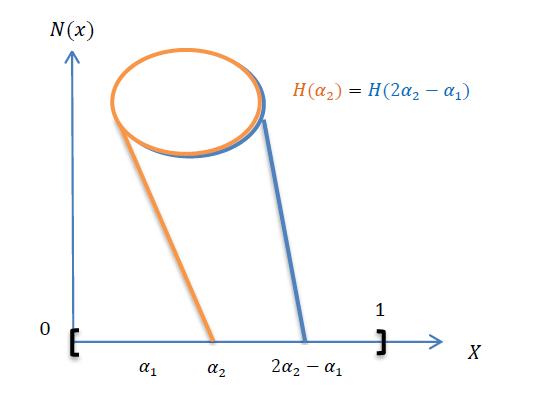
3.3 Definition
If a set-valued mapping , - ( ) satisfies ,( ) ( ) * ( ) ( )+ ( ), then is called a collection of neutrosophic neut-sleeves on . A set composed of all the collection of neutrosophic neut-sleeves on is written as ( ). The ideal neutrosophic neut-sleeve on occurs in the case of ( ) ( ) ( ) .
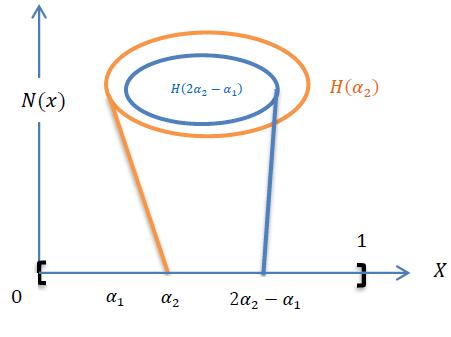 Huda E. Khalid, Florentin Smarandache & Ahmed K. Essa, The Basic Notions for (over, off, under) Neutrosophic Geometric Programming Problems
Huda E. Khalid, Florentin Smarandache & Ahmed K. Essa, The Basic Notions for (over, off, under) Neutrosophic Geometric Programming Problems
Note that:
The ideal case of neutrosophic neut-sleeve is composed from the ideal case of the neutrosophic sleeve combined with the ideal case of the neutrosophic anti-sleeve.
Figure 8: Neutrosophic neut-sleeve
Figure 9: Neutrosophic ideal neut-sleeve
Note that:
All figures from 4 to 9 are just indicative graphs employed to understand the meaning of neutrosophic sleeves, neutrosophic anti-sleeves and neutrosophic neut-sleeves, but are not necessary accurate.
Huda E. Khalid, Florentin Smarandache & Ahmed K. Essa, The Basic Notions for (over, off, under) Neutrosophic Geometric Programming Problems
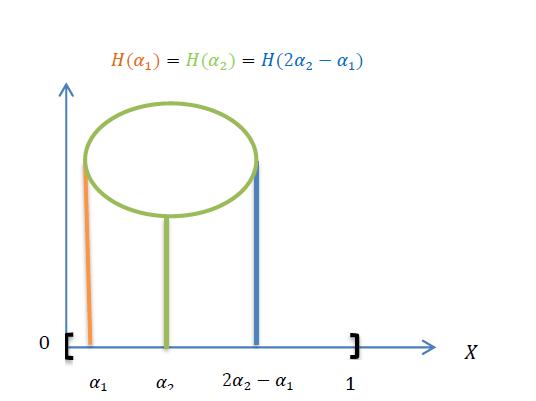
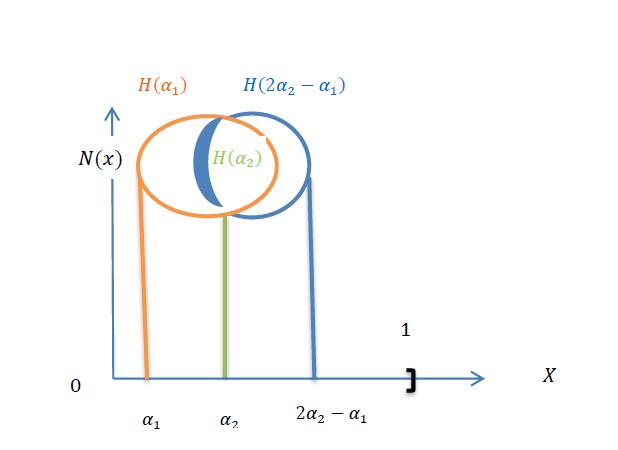
4 A new insight of the excluded-middle law in neutrosophic theory
4.1 The excluded-middle law in classical and fuzzy logics
In classical dialectics, the excluded middle law is the third of the three classic laws of thought. It states that for any proposal, either that proposal is true, or its contradictory is true. The earliest known formulation was in Aristotle’s discussion of the principle of non-contradiction, where he said that of two contradictory suggestion, one of them must be true, and the other is false. Aristotle 384 BC, said that it is necessary for every claim there are two opposite parts, either confirm or deny and it is unattainable that there should be anything between the two parts of an opposition. We point out that fuzzy logic, intuitionistic fuzzy logic and neutrosophic logic no longer satisfy the excluded-middle law [3].
Let be an ordinary fuzzy set, whose generic elements are denoted by , a mapping , - ( ) called a fuzzy set , and let the complement of be with its membership function meaning ( ) ( ), then it is obvious that the excluded-middle law is not satisfied ( ) ( ) ( ) ( ) ( ) ( )
Example: Let , - ( ) , then ( ) , while ( )( ) { ( ) ( )( ) { ( )
Hence & Especially, ( )( ) ( )( ) ( )
A fuzzy set operation does not satisfy the excluded-middle law, which complicates the study of fuzzy sets. The fuzzy sets can provide more objective properties than the classical sets [1]
4.2 The excluded middle law with the perspective of (over, off, under) neutrosophic geometric programming
In the two-valued logic, all the designated values as types of truth and all the anti-designated values as types of untruth with gaps between truth-value (or falsehood-value). In the neutrosophic theory, one specifies the non-designated values as types of indeterminacy and thus, each neutrosophic consequences have degrees of designated, non-designated, and anti-designated values. However, the excluded middle law in the neutrosophic system does no longer work [7]
Even more, Smarandache (2014) [3] generalized the Law of Included Middle to the Law of Included Multiple-Middles, showing that in refined neutrosophic logic (2013), between truth (T) and falsehood (F) there are multiple types of sub-indeterminacies (I1, I2, …) [10,11,12].
Huda E. Khalid, Florentin Smarandache & Ahmed K. Essa, The Basic Notions for (over, off, under) Neutrosophic Geometric Programming Problems
In upcoming definitions, the authors affirm that ( ) ( ) in neutrosophic environment; for example but not limited to, the nonlinear neutrosophic programming ( i.e. example of neutrosophic geometric programming (NGP)).
4.2.1 Definition
Let ( ) be the set of all neutrosophic variable vectors , i.e. ( ) *( ) +. The function ( ) ( ) is said to be neutrosophic GP function of , where ( ) ∑ ∏ is a constant , being an arbitrary real number.
4.2.2 Definition
Let ( ) be a neutrosophic geometric function in any neutrosophic geometric programming, and let be the neutrosophic set for all functions ( ) that are neutrosophically less than or equal to one.
* ( ) + { ( ) ( ( )) ( ( )) } ( )
4.2.3 Definition
Let ( ) be any neutrosophic geometric function written as a constraint in any neutrosophic geometric programming (NGP), where , - , - and ( ) is an m-dimensional neutrosophic variable vector. Call the inequality ( ) ( ) where denotes the neutrosophied version of with the linguistic interpretation being "less than (the original claimed), greater than (the anti-claim of the original less than), or equal (neither the original claim nor the anti-claim)" The constraint (1) can be redefined into three constraints as follow:( ) ( ( )) ( ( )) } ( )
4.2.4 Definition
Let be the set of all neutrosophic geometric functions that neutrosophically less than or equal to one, i.e. * ( ) + { ( ) ( ( )) ( ( )) }
It is significant to define the following membership functions: ( ( )) { ( ) ( ( ( ) ) ( ( ( )) ) ) ( ) ( ) ( ( ( ))) { ( ) ( ( ( ( )) ) ( ( ) )) ( ) ( )
It is clear that ( ( ( ))) consists from the intersection of the following functions: ( ( ) ) ( ( ( )) )
Huda E. Khalid, Florentin Smarandache & Ahmed K. Essa, The Basic Notions for (over, off, under) Neutrosophic Geometric Programming Problems
i.e. ( ( ( ))) { ( ( ( )) ) ( ) ( ( ) ) ( ) ( )
Note that is a constant expressing a limit of the admissible violation of the neutrosophic geometric function ( ) Consequently, ( ( )) . ( ( ))/ Here ( ( )) . ( ( ))/ ( ( ( )))
5 ( ) and strong ( ) of Neutrosophic sets
We put the following definitions as an initial step to prepare to prove the properties of ( ) and strong f ( ) of neutrosophic sets.
5.1 Definition
Let ( ) ( ) , - , written ( ) * ( ) ( ) ( ) +, ( ) is said to be an ( ) set of a neutrosophic set . Again, we write ( ) * ( ) ( ) ( ) +, ( ) is said to be a strong ( ) set of a neutrosophic set , ( ) are confidence levels and
5.2 Definition
Let ( ) written ( ) * ( ) ( ) ( ) + , ( ) is called a support of a neutrosophic set Again, * ( ) ( ) ( ) + is called a kernel of neutrosophic set , and is a normal neutrosophic set for
5.3 Definition
Let ( ) written *⟨ . ( ) ( )/ ( ( ) ( )) ( ( ) ( ))⟩ +, the union of *⟨ . ( ) ( )/ ( ( ) ( )) ( ( ) ( ))⟩ +, the intersection of
5.4 Theorem
We have the following properties for ( ) and strong ( ) neutrosophic sets: 1- ( ) ( ) 2- ( )( ) ( ) ( ) equality holds if . ( )( ) ( ) ( ) 3- ( )( ) ( ) ( ) , equality holds if ( )( ) ( ) ( )
Huda E. Khalid, Florentin Smarandache & Ahmed K. Essa, The Basic Notions for (over, off, under) Neutrosophic Geometric Programming Problems
Proof
1- Let ( ) ( ) ( ) ( ) But ( ) ( ) ( ) ( ) ( ) ( ) ( ) ( ) ( ) ( ) , therefore ( ) ( ) 2- ( )( ) ( ) ( ) Since ( ) ( ) and from 1 above, we have: ( ) ( )( ) ( ) ( ) ( )( ) ( ) Combine (12) with (13). The proof of property 2 is complete, i.e. ( )( ) ( ) ( ) ( ) If , we show that ( )( ) ( ) ( ) Let ( )( ) ( ) ( ) ( ) ( ) ( ) ( ) if ( ) ( ) then ( ) ( ) ( ) ( ) also if ( ) ( ) then ( ) ( ) ( ) ( ) ( ) ( ) and so ( )( ) ( ) ( ) ( ) From (14) and (15), we get ( )( ) ( ) ( ) We still need to prove that ( )( ) ( ) ( ) Proof
Since ( )( ) ( ) ( )( ) ( ) ( ) Let ( ) ( ) ( ) ( ) ( ) ( ) ( ) and ( ) ( ) ( ) ( ) ( ) ( ) ( ) ( ) ( ) ( )( ) ( ) ( ) ( )( ) ( ) From (16) and (17), we have ( )( ) ( ) ( )
Note that: The same technique that used for proving 2 will be employed to prove the properties of strong (α,β,γ)-cut in 3.
6 Representations of neutrosophic sets
The decomposition theorems of neutrosophic sets is a bridge between neutrosophic sets and ordinary ones. The principal feature of ( ) and strong ( ) sets in neutrosophic set theory is the capability to represent neutrosophic sets. We show in this section that each neutrosophic set can uniquely be represented by either the family of all its ( ) or the family of all its strong ( ) We can convert each of ( ) and strong ( ) to special neutrosophic sets denoted by ( ) ( ) , as follows:
for , - , we have:
Huda E. Khalid, Florentin Smarandache & Ahmed K. Essa, The Basic Notions for (over, off, under) Neutrosophic Geometric Programming Problems
( ) {( ) ( ) ( ) ( ) ( )
( ) {( ) ( ) ( ) ( ) ( )
The representation of an arbitrary neutrosophic set in terms of the special neutrosophic sets ( ) , which are defined in terms of the ( ) of by (18), is usually referred to as decomposition of . In the following, we formulate and prove two basic decomposition theorems of neutrosophic sets.
6.1 First Decomposition theorem of neutrosophic set (NS)
For every ( ), , - ( ) , where ( ) is defined by (18) and denotes the standard neutrosophic union. Proof
For each particular let ( ) ( ) ( ) . Then, . , - ( ) /( ) ( ( ) ,( ) ,( ) , -) [( ( ) ,( ) ,( ) , -) ( ( ) (( ) ,( ) , - )]
For each ( -, we have ( ) and, therefore, ( ) ( ). On the other hand, for each , -, we have ( ) , therefore, ( ) ( ).
The second step of the prove is to complete the maximum value for the second component ( ( ) , -) as follow: . , - ( ) /( ) [( ( ) ,( ) ,( ) , -) ( ( ) ,( ) (( ) , -)]
For each ( -, we have ( ) and, therefore, ( ) ( ). On the other hand, for each , -, we have ( ) , therefore, ( ) ( ). ( ( ) ,( ) ,( ) , -)
The final step of the proof is to complete the maximum value for the third component ( ( ) , -),
. , - ( ) /( ) [( ( ) ,( ) ,( ) , )) ( ( ) ,( ) ,( ) , -)]
For each , -, we have ( ) , therefore, ( ) ( ). On the other hand, for each , ), we have ( ) , therefore, ( ) ( ) Consequently,
Huda E. Khalid, Florentin Smarandache & Ahmed K. Essa, The Basic Notions for (over, off, under) Neutrosophic Geometric Programming Problems
. , - ( ) /( ) ( ( ) ,( ) ,( ) , -) ( ) ( )
Since the same argument is valid for each , the theorem is proved. ▀
6.2 Second Decomposition Theorem of Neutrosophic Set (NS)
Let be any non-empty set. For a neutrosophic subset ( ), , - ( ) , where ( ) is defined by (19) ,and denotes the standard neutrosophic union.
Proof:
For each particular let ( ) ( ) ( ) . Then . , - ( ) /( ) ( ( ) ,( ) ,( ) , -)
[( ( ) , ) ( ) ,( ) , -) ( ( ) ,( ) ,( ) , -)]
For each , -, we have ( ) and, therefore, ( ) ( ). On the other hand, for each , ), we have ( ) , therefore, ( ) ( ) the second step of the proof is to complete the maximum value for the second component ( ( ) , -) Again, . , - ( ) /( ) [( ( ) , ) ( ) , ) ( ) , -) ( ( ) ,( ) ,( ) , -)]
For each , -, we have ( ) and, therefore, ( ) ( ). On the other hand, for each , ), we have ( ) , therefore, ( ) ( ). . , - ( ) /( ) ( ( ) , ) ( ) , ) ( ) , -)
The final step of the proof is to complete the maximum value for the third component ( ( ) , -). Finally, . , - ( ) /( ) [( ( ) , ) ( ) , ) ( ) , -) ( ( ) , ) ( ) , ) ( ) ( -)]
For each ( -, we have ( ) , therefore, ( ) ( ). On the other hand, for each , -, we have ( ) , therefore, ( ) ( ) Consequently, . , - ( ) /( ) ( ( ) , ) ( ) , ) ( ) ( -) ( ) ( )
Since the same argument is valid for each , therefore the theorem is proved. ▀
Conclusion
Neutrosophic geometric programming (NGP) can find many application areas, such as power engineering, postal services, look for exemplars for eliminating waste-water in a power plant, or determining the power equipping radius in the electrical transformers. All the above-mentioned
Huda E. Khalid, Florentin Smarandache & Ahmed K. Essa, The Basic Notions for (over, off, under) Neutrosophic Geometric Programming Problems
Neutrosophic
and
applications require building a strong neutrosophic theory for neutrosophic geometric programming (NGP), these aims lead the authors to present the (over, off, under) convexity condition in neutrosophic geometric functions. The needed of establishing the aspects of sleeves, neut sleeves and anti-sleeves were necessary. Furthermore, the basic concept of (α,β,γ)-cut and strong (α,β,γ)-cut of neutrosophic sets have been given. By strong definitions and given example, the authors proved that the excluded middle law has no longer satisfied in neutrosophic theory, this proof has been made by neutrosophic geometrical programming.
Acknowledgement
This research is supported by the Neutrosophic Science International Association (NSIA) in both of its headquarter in New Mexico University and its Iraqi branch at Telafer University, for more details about (NSIA) see the book entitled “Neutrosophic Logic: the Revolutionary Logic in Science and Philosophy”
Reference
[1] B. Y. Cao "Fuzzy Geometric Programming". SPRINGER-SCIENCE +BUSINESS MEDIA, B. V. 2002
[2] F. Smarandache “Neutrosophic Overset, Neutrosophic Underset, and Neutrosophic Offset”, Pons Editions, Brussels, 2016.
[3] F. Smarandache “Law of Included Multiple-Middle & Principle of Dynamic Neutrosophic Opposition” EuropaNova & Education Publisher Brussels-Columbus, 2014.
[4] F. Smarandache & Huda E. Khalid "Neutrosophic Precalculus and Neutrosophic Calculus". Second enlarged edition, Pons asbl 5, Quai du Batelage, Brussels, Belgium, European Union, 2018.
[5] F. Smarandache,” Interval-Valued Neutrosophic Oversets, Neutrosophic Undersets, and Neutrosophic Offsets”, journal of science and engineering investigations, vol. 5, 2016, pp. 1- 4.
[6] F. Smarandache,” Operators on Single-Valued Neutrosophic Oversets, Neutrosophic Undersets, and Neutrosophic Offsets”, Journal of Mathematics and Informatics, vol. 5, 2016, pp. 63- 67.
[7] F. Smarandache, “A unifying Field in Logics: Neutrosophic Logic. Neutrosophic Probability, Neutrosophic Statistics, Neutrosophic Sets”, second version, “Collected Papers”, vol. III. Oradea (Romania): Abaddaba, 2000.
[8] F. Smarandache, H. E. Khalid, A. K. Essa, M. Ali , “The Concept of Neutrosophic Less Than or Equal To: A New Insight in Unconstrained Geometric Programming”, Critical Review, Volume XII, 2016, pp. 72-80
[9] F. Smarandache, H. E. Khalid & A. K. Essa, “Neutrosophic Logic: the Revolutionary Logic in Science and Philosophy” , Proceedings of the National Symposium , EuropaNova, Brussels, 2018.
[10] F. Smarandache, “Unmatter as a Consequence of the Law of Included Multiple-Middles”, Annual Meeting of the APS Four Corners Section, Vol. 60, Number 11, Friday–Saturday, October 16–17, 2015; Tempe, Arizona, http://meetings.aps.org/Meeting/4CF15/Session/F1.66
[11] F. Smarandache, “n-Valued Refined Neutrosophic Logic and Its Applications to Physics”, Bulletin of the American Physical Society 2013 Annual Fall Meeting of the APS Ohio-Region Section Volume 58, Number 9. Friday–Saturday, October 4–5, 2013; Cincinnati, Ohio, http://meetings.aps.org/Meeting/OSF13/Event/205641
[12] F. Smarandache, “n-Valued Refined Neutrosophic Logic and Its Applications in Physics”, Progress in Physics, 143-146, Vol. 4, 2013; https://arxiv.org/ftp/arxiv/papers/1407/1407.1041.pdf
[13] G. J. Klir, Bo Yuan . “Fuzzy Sets and Fuzzy Logic Theory and Applications”, Published by Prentice Hall PTR, 1995.
[14] H. E. Khalid, “An Original Notion to Find Maximal Solution in the Fuzzy Neutrosophic Relation Equations (FNRE) with Geometric Programming (GP) ”, Neutrosophic Sets and Systems, vol. 7, 2015, pp. 3-7
[15] H. E. Khalid, “The Novel Attempt for Finding Minimum Solution in Fuzzy Neutrosophic Relational Geometric Programming (FNRGP) with (max, min) Composition”, Neutrosophic Sets and Systems, vol. 11, 2016, pp. 107-111.
[16] K.T. Atanassov, “Intuitionistic Fuzzy Sets”, Fuzzy Sets and Systems, vol. 20, 1986, pp. 87-96.
[17] S. Pramanik, and T.K. Roy. ”Intuitionistic fuzzy goal programming and its application in solving multiobjective transportation problem” Tamsui Oxford Journal of Management Sciences 23(1),2007, 01–16.
[18] S. Pramanik, P.P. Dey, T. K. Roy. “Bilevel programming in an intuitionistic fuzzy environment” . Journal of Technology 42, 2011,103-114.
Huda E. Khalid, Florentin Smarandache & Ahmed K. Essa, The Basic Notions for (over, off, under) Neutrosophic Geometric Programming Problems
